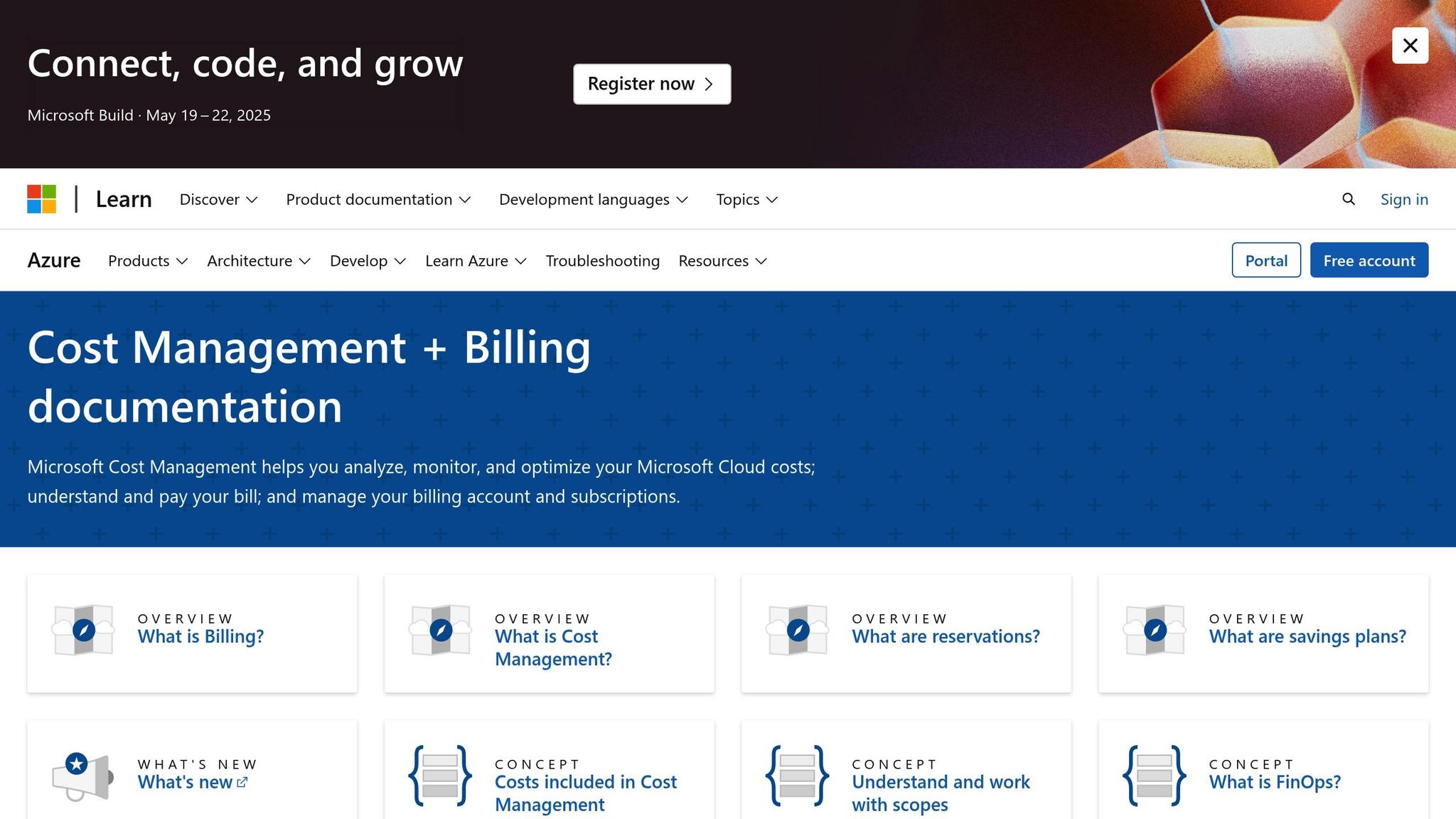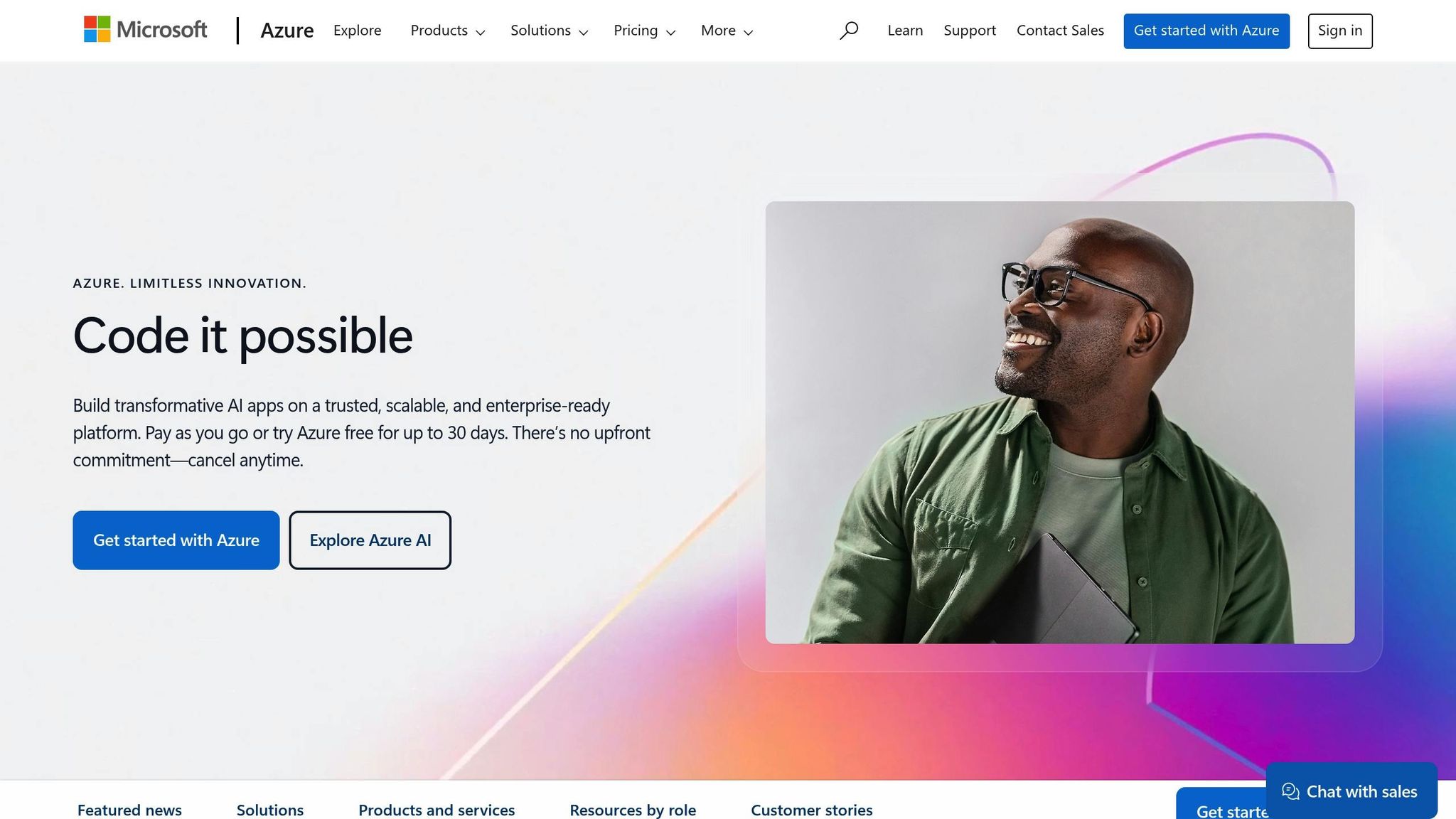Checklist for Reviewing Azure Budgets Monthly
Effectively manage Azure budgets with a comprehensive monthly review checklist to control costs and optimise resource use.

Managing Azure budgets effectively can save you money and ensure resources align with your business needs. Here's how to stay on top of your cloud spending:
Key Steps:
- Compare Budget vs Actual Costs: Use Azure Cost Management to spot overspending or underutilisation.
- Identify Cost-Saving Opportunities: Look for unused resources, optimise services, and apply discounts like Reserved Instances or Azure Hybrid Benefit.
- Monitor Spending Trends: Set alerts at 70%, 85%, and 95% of your budget to act quickly.
- Organise Monthly Reviews: Schedule early in the month, share key reports, and involve relevant teams.
- Update Budgets: Adjust based on insights, reallocate funds, and document all changes.
Quick Comparison Table:
| Category | Action | Example |
|---|---|---|
| Cost Monitoring | Track spending vs budget | Compute overspend: +15.02% |
| Unused Resources | Remove or optimise underused services | Idle VMs, low-use databases |
| Discounts | Apply cost-saving programmes | Reserved Instances, Hybrid Benefit |
| Alerts | Set thresholds for notifications | 70%, 85%, 95% budget usage |
By following these steps, you’ll gain better control over Azure costs and ensure your spending aligns with business goals. For detailed guidance, visit Azure Optimisation Tips, Costs & Best Practices.
Azure Cost Management Tutorial | Analyzing and reacting to ...

Before Starting the Review
Getting everything in order beforehand ensures your Azure budget review stays focused and helps make better decisions about cloud spending.
Gather Budget Data
Start by pulling together key cost reports from the Azure Cost Management portal. Make sure all figures are in GBP (£) and use the dd/mm/yyyy date format. Include:
- Detailed billing statements from the previous month
- Resource usage reports to understand consumption patterns
- Cost allocation data broken down by departments
- Historical spending trends for year-on-year comparisons
Confirm Azure Tool Access

Make sure your team has the right access to Azure tools before the review begins.
| Role | Required Access | Purpose |
|---|---|---|
| Budget Reviewer | Read-only Cost Management | To view spending data and reports |
| Finance Manager | Cost Management Contributor | To analyse costs and establish budgets |
| Resource Admin | Resource Group Contributor | To manage and allocate resources |
Use role-based access control (RBAC) to keep costs secure and track access.
Organise the Review Meeting
Plan the meeting for early in the month so any changes can be implemented quickly.
Agenda: Go over last month's spending against the budget, review resource usage, highlight any unexpected charges, and outline steps to reduce costs.
Set clear goals for the meeting and share relevant reports as pre-reading materials. Make sure all participants have access to the necessary collaborative tools.
Once everything is in place, you’ll be ready to dive into the spending review.
Check Current Spending
Take a closer look at your Azure spending to understand where your money is going.
Budget vs Actual Costs
Use Azure Cost Management to compare your planned budget with actual expenses. Spot any major differences that might need immediate attention.
| Cost Category | Planned Budget | Actual Spending | Variance |
|---|---|---|---|
| Compute Resources | £2,500.00 | £2,875.50 | +15.02% |
| Storage | £750.00 | £685.25 | -8.63% |
| Networking | £500.00 | £525.75 | +5.15% |
| Database Services | £1,200.00 | £1,150.25 | -4.15% |
This comparison helps you pinpoint areas that need further investigation, whether it's overuse or underuse of resources.
Resource Cost Breakdown
Dive deeper into spending by breaking it down into specific categories:
- Subscription Level: Look at total costs across all subscriptions to get a high-level view.
- Resource Groups: Examine spending tied to particular projects or applications. Identify groups that consume a large share of your budget.
- Service Categories: Find out which Azure services are contributing the most to your costs.
- Department Tags: Track spending across business units to ensure costs are properly allocated.
Be extra vigilant with resources that have variable pricing, such as virtual machines with pay-as-you-go rates or storage accounts that charge based on transactions.
Find Unusual Charges
Identify unexpected cost spikes or anomalies that could be inflating your Azure bill:
- Bandwidth Costs: Watch for unexpected data transfer charges, especially for inter-region traffic.
- Orphaned Resources: Locate resources still running after projects have ended, as these can quietly add up.
- Over-Provisioned Services: Check for oversized virtual machines or databases that exceed the workload's needs.
- Development Resources: Ensure development and testing environments are not running outside regular working hours.
Set up cost alerts to flag any service exceeding 10% of its usual monthly usage, so you can act quickly.
| Service Type | Common Unexpected Charges |
|---|---|
| Storage Accounts | High transaction volumes, geo-redundancy costs |
| Virtual Machines | Premium disks left running, unused reserved instances |
| Databases | Excess DTU usage, backup storage charges |
| Networking | Inter-region data transfer, unexpected egress charges |
Find Cost-Saving Options
Analyse your Azure spending habits to uncover ways to cut costs.
Main Cost Sources
Azure Cost Management provides a clear view of your most expensive services and resources, helping you focus your optimisation efforts. Pay attention to resource consumption trends that might signal inefficiencies:
| Resource Type | Common Cost Drivers | Optimisation Strategies |
|---|---|---|
| Compute | Long VM runtimes | Adjust sizes, schedule auto-shutdowns |
| Storage | Duplicate data, premium tiers | Manage data lifecycle, switch to lower-cost tiers |
| Networking | Inter-region traffic | Optimise traffic routes, manage data transfers carefully |
| Databases | Excess capacity | Reassess performance tiers |
After this, identify resources that are underused or not cost-effective.
Find Unused Resources
Conduct a detailed review of your Azure setup to spot underutilised resources. Examples include:
- Virtual Machines: Check for VMs with consistently low CPU usage over time.
- Storage Accounts: Identify blob containers with little to no access activity.
- Databases: Look for databases with minimal query activity.
- Network Resources: Highlight unused public IPs and idle load balancers.
Review Active Discounts
Ensure you're taking full advantage of cost-reduction programmes for eligible resources:
| Discount Type | Key Areas to Check | Recommended Actions |
|---|---|---|
| Reserved Instances | Gaps in coverage | Align reservations with workload patterns |
| Azure Hybrid Benefit | Licence usage | Apply to qualifying virtual machines |
| Dev/Test Pricing | Development environments | Convert applicable subscriptions |
| Enterprise Agreements | Commitment levels | Adjust based on current consumption |
Apply Expert Tips
Boost your savings with these practical tips:
- Resource Scheduling: Automate shutdowns for non-production environments during off-hours.
- Storage Management: Shift rarely accessed data to cooler, lower-cost storage tiers.
- Right-Sizing: Match resource configurations to actual usage needs.
- Cost Tracking: Use tagging to monitor spending by department or project.
Keep an eye on these changes monthly to ensure they're still effective and that performance remains consistent.
Update Budget Plans
Make adjustments to your budget based on the insights gained from your cost-saving analysis.
Change Budget Amounts
Evaluate your Azure spending and modify budgets where necessary:
| Budget Category | Key Considerations | Actions |
|---|---|---|
| Resource Groups | Analyse usage patterns and future growth | Reassign funds based on actual utilisation |
| Development Environments | Consider off-hours usage | Lower budgets for non-production resources during downtime |
| Storage Solutions | Review data lifecycle needs | Optimise spending by adjusting to cost-efficient storage tiers |
| Compute Resources | Monitor performance metrics | Align budgets with actual usage and demand |
Shift funds away from underused resources and redirect them to critical services. Ensure all updates are logged immediately to maintain transparency.
Record and Share Changes
Keep track of all budget updates:
- Write down the previous and updated budget figures, the reasons for the changes, and the expected outcomes.
- Use your organisation’s preferred communication tools to share these updates with relevant teams.
- Arrange short team meetings to explain major budget changes and gather feedback.
Ensure the documentation is accessible to all relevant stakeholders, while maintaining proper access controls within Azure.
Set Budget Alerts
Set up alerts to monitor spending and take timely actions:
| Alert Level | Threshold | Who Gets Notified |
|---|---|---|
| Initial Warning | 70% of the monthly budget | Resource owners, finance team |
| Action Required | 85% of the monthly budget | Department managers, IT leads |
| Emergency Response | 95% of the monthly budget | Senior management, budget controllers |
At 70%, send a warning email to allow time for adjustments. At 85%, automated reports can spotlight high-cost resources and recent spending trends. At 95%, urgent alerts should trigger immediate action to control costs.
For more tips on managing Azure expenses effectively, check out Azure Optimization Tips, Costs & Best Practices.
Create Review Reports
Share your Azure budget review findings to help shape upcoming decisions.
List Main Findings
Highlight key data in these areas:
| Report Section | Key Elements | Details to Include |
|---|---|---|
| Cost Trends | Monthly spending patterns | Percentage changes and peak usage details |
| Resource Analysis | Resource utilisation rates | Identify underused and overused resources |
| Budget Adherence | Variance analysis | Highlight areas over or under budget |
| Cost Optimisation | Implemented changes | Note savings achieved and pending actions |
These findings provide a foundation for comparing current performance with previous periods.
Compare Results
| Metric | Previous Month | Current Month | Difference |
|---|---|---|---|
| Total Spend | £12,500 | £11,750 | -6% |
| Resource Groups | £8,000 | £7,200 | -10% |
| Storage Costs | £2,500 | £2,550 | +2% |
| Compute Services | £2,000 | £2,000 | 0% |
Document the cost-saving results and identify areas that need attention.
Plan Next Review
Use the insights from this review to prepare for the next one.
| Planning Element | Action Items | Timeline |
|---|---|---|
| Review Schedule | Set the next review date | First Tuesday of each month |
| Data Collection | Assign team members to gather metrics | One week before the review |
| Analysis Tasks | Assign deep-dive analysis responsibilities | Three days before the review |
| Follow-up Items | Monitor the implementation of recommendations | Ongoing |
Set up a shared calendar for all stakeholders, ensuring deadlines and responsibilities are clear.
UK Format Requirements
Standardise Azure budget reports using UK formatting.
UK Money and Date Format
Set up your Azure portal to display costs in British Pounds Sterling (GBP) with the correct UK formatting:
| Element | UK Format | Example |
|---|---|---|
| Currency Symbol | £ before numbers | £1,250.50 |
| Decimal Separator | Full stop (.) | £10.75 |
| Thousand Separator | Comma (,) | £1,000,000 |
| Date Format | dd/mm/yyyy | 03/05/2025 |
| Time Format | 24-hour clock | 14:30 |
Make sure your Azure account settings reflect these UK formatting standards when exporting reports. This ensures financial reports are aligned with UK conventions.
UK Units and Spelling
Follow British English conventions across all Azure budget documentation:
| Category | UK Standard | Application |
|---|---|---|
| Data Storage | GB, TB (no full stops) | 500 GB storage usage |
| Network Traffic | Mbps, Gbps | 10 Gbps bandwidth |
| Common Terms | - Optimisation (not optimization) - Utilisation (not utilization) - Customise (not customize) |
Use in report headings and documentation |
| Numbers | Write out numbers under 10 | "five instances" vs "15 instances" |
Ensure these standards are applied consistently across all budget review documents for a professional and clear presentation in Azure cost management.
Conclusion
Reviewing your Azure budget every month is a practical way to manage costs and make better use of resources. These regular reviews help small and medium-sized businesses (SMBs) spot ways to save money and ensure Azure spending aligns with their business goals. Here's a quick recap of the key steps for effective budget management.
Key Areas to Focus On:
1. Cost Monitoring and Analysis
- Track your spending against the budget and analyse trends.
- Pinpoint the main cost drivers in your Azure setup.
- Look out for unusual charges that could signal configuration issues.
2. Resource Management
- Remove resources that aren't being used.
- Take advantage of discounts and reserved instances where applicable.
- Set up budget alerts to warn you when spending approaches your limits.
3. Documentation and Communication
- Keep detailed records of any budget changes.
- Share updates and findings with key stakeholders in a clear format.
- Regularly check on the impact of changes you’ve implemented.
By following these steps, you can keep your Azure costs under control while ensuring resources are used effectively. Setting up automated alerts to notify your team when spending gets close to your set limits can also help you stay ahead of potential overspending.
For more tips and detailed guidance, visit Azure Optimisation Tips, Costs & Best Practices.
FAQs
How can I make sure my team has the right access to Azure tools for reviewing budgets?
To ensure your team has the correct access to Azure tools for budget reviews, start by verifying their roles and permissions in the Azure portal. Assign appropriate Role-Based Access Control (RBAC) roles, such as 'Reader' for viewing budgets or 'Contributor' for making adjustments. This ensures that team members can only access the tools and data relevant to their responsibilities.
Regularly review and update these permissions to align with any changes in team roles or project requirements. It's also a good idea to use Azure Active Directory to manage team access efficiently and securely.
How can I identify and optimise underutilised Azure resources to reduce costs?
To identify and optimise underutilised resources in Azure, start by analysing your usage patterns through Azure Cost Management and the Azure Advisor tool. These tools highlight areas where resources are underused, such as virtual machines running at low capacity or unused storage accounts.
Once identified, you can take steps to optimise these resources. For example, resize virtual machines to a smaller instance, consolidate workloads, or delete unused resources. Regularly reviewing your Azure budgets and resource usage can help ensure cost efficiency. For more detailed guidance, consider exploring expert tips on Azure optimisation tailored for SMBs.
How can I use budget alerts to manage my Azure costs effectively?
To manage your Azure costs effectively, set up budget alerts to notify you when your spending reaches specific thresholds. These alerts help you stay informed and take timely action to avoid overspending.
You can configure alerts to trigger at different percentages of your budget, such as 50%, 75%, or 90%, ensuring you have ample time to review and adjust your usage. Regularly monitoring these alerts and reviewing your Azure budgets can help you maintain cost efficiency and optimise your cloud spending.




